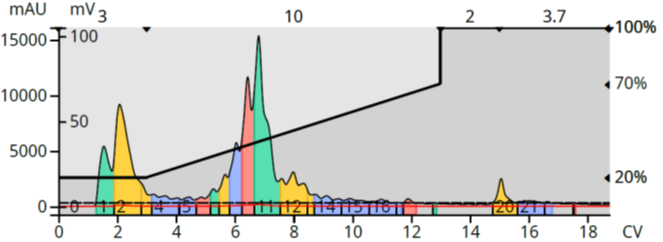Are you currently or have you ever had an issue where your chromatographic trace shows a sine-wave pattern while a compound is eluting, Figure 1? If so, there are several causes, and solutions, for this issue.

- A. Solvent Immiscibility
When using UV to detect eluting compounds it is critical that all solvents used in the method are fully miscible. If not, when the solvents are mixed and pass through the column, they can form emulsions. Emulsions will intermittently block UV light leading to a wavy trace.
How to fix the issue:
Ensure solvent A and B are miscible. For example, hexane is not miscible with acetonitrile or methanol but is miscible with ethyl acetate, acetone, dichloromethane, and methyl t-butyl ether, among other solvents. If unsure, click on the link above (miscible).
- B. Pressure Fluctuations
There can be a few causes of pressure fluctuations including...
-
- 1. Check valve seals
Flash chromatography systems have pumps and pumps have check valves to ensure solvent lines remain pressurized when the pump is filling with solvent. Over time, these valves can wear or accumulate debris and need to be cleaned or replaced. There are typically two symptoms seen with check valve issues.
- A. Wavy or spiky chromatography
- B. Reduced solvent flow
How to fix the issue:
- A. Sometimes the flash system (e.g. Biotage® Isolera, Selekt) has a protocol to follow to clean the check valves and restore their integrity
- B. Sometimes the check valve needs to be replaced. This is something you can do if you own a Biotage flash system.
- 2. Outgassing
Most commonly encountered in reversed-phase flash chromatography, the chromatogram waviness is a result of the mixing of water (and its dissolved oxygen) and the organic solvent (methanol or acetonitrile). When water mixes with these solvents, the entrapped oxygen is released. In fact, if you mix 50 mL of methanol with 50 mL of water, the total volume is less than 100 mL because of the mixture liberating the oxygen!
The oxygen tends to stay dissolved when the solvent is under pressure (e.g. the tubing leading to the column). When the solvent exits the column, there is a significant enough pressure drop to allow the air to escape which causes changes in the flash system’s back pressure. It is the back pressure oscillation which generates the chromatogram’s waviness. This outgassing, as it is called, typically occurs somewhere between 20% and 70% organic solvent.
How to fix the issue: There are several options…
- A. Increase the method’s flow rate. I typically will run a 6-gram Biotage® Sfär C18 at 20 mL/min and a 12-gram Sfär C18 column at 40 mL/min
- B. Sonicate each of the solvents for 10-15 minutes
- C. Purge your water with argon, helium, or nitrogen (the first two gasses work best). These gases will displace dissolved oxygen.
-
Interested in other chromatography tips? Download our whitepaper – Successful Flash Chromatography.